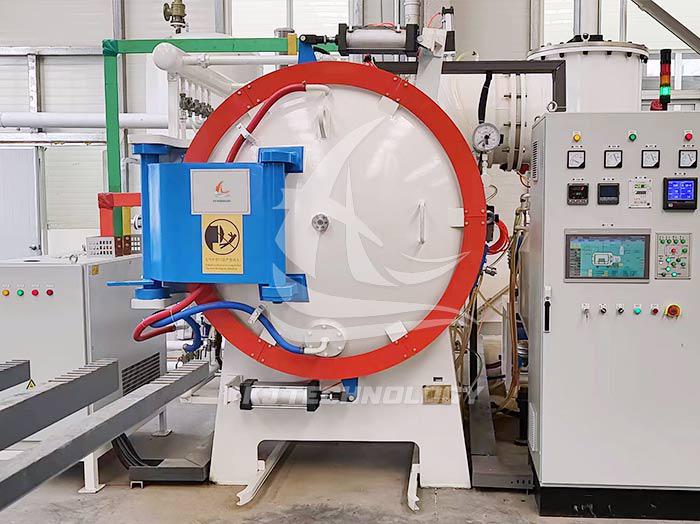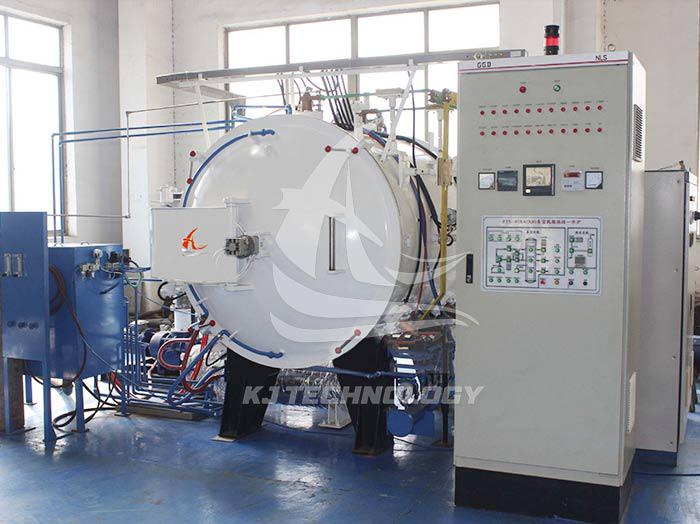Daily maintenance of vacuum aluminum brazing furnace
 06-12-2025 Author: KJ technology
06-12-2025 Author: KJ technology
The daily maintenance of vacuum aluminum brazing furnace is the key to ensuring long-term stable operation of equipment, extending service life, and ensuring welding quality. The following provides a detailed introduction to the daily maintenance content from the aspects of cleaning and maintenance, component inspection, lubrication and maintenance, electrical system maintenance, operation records, and regular calibration:
1. Cleaning and maintenance
Internal cleaning of furnace body
Furnace cleaning: After each welding is completed, wait for the furnace to cool to a safe temperature and use a vacuum cleaner or soft bristled brush to remove aluminum shavings, solder residue, and other impurities from the furnace to avoid residue evaporating at high temperatures, polluting the vacuum environment, or affecting the quality of the next welding.
Heating element cleaning: Regularly check whether there is an oxide layer or impurities adhering to the surface of the heating element (such as graphite heating tube). If necessary, use fine sandpaper to gently polish and remove the oxide layer, but be careful not to damage the heating element.
Insulation material inspection: Check whether the insulation material (such as ceramic fiber felt) is damaged, detached, or deformed. If there are any problems, replace them in a timely manner to ensure the insulation performance of the furnace.
Vacuum system cleaning
Vacuum pump maintenance: According to the user manual of the vacuum pump, regularly replace the pump oil and clean the oil filter. Generally, the pump oil should be replaced every 200-300 hours of operation, and the oil filter should be cleaned every 500 hours of operation.
Vacuum pipeline cleaning: Check the inner wall of the vacuum pipeline for oil stains, dust, or other impurities. If necessary, specialized cleaning agents can be used for cleaning, and then dried with dry compressed air.
Cleaning of valve sealing surface: Regularly inspect the sealing surface of the vacuum valve, remove impurities and dirt on the sealing surface, and ensure the sealing performance of the valve.
external cleaning
Cleaning of furnace surface: Use a clean damp cloth to wipe the surface of the furnace to remove dust and stains. Avoid using corrosive cleaning agents to prevent damage to the surface coating of the furnace body.
Control panel cleaning: Gently wipe the control panel with a clean soft cloth to prevent dust and debris from entering the gaps between the buttons and affecting operation.
2. Component inspection
Seal inspection
Furnace door sealing ring: Check the furnace door sealing ring for damage, aging, or deformation before each start-up. If there is a problem, replace the sealing ring in a timely manner to ensure good sealing after the furnace door is closed.
Vacuum pipeline seals: Regularly inspect the seals at the flange connections and valve seals of the vacuum pipeline. If there are signs of leakage, replace the seals in a timely manner.
Heating element inspection
Resistance measurement: Regularly use a multimeter to measure the resistance value of the heating element and compare it with the rated resistance value. If the deviation of the resistance value exceeds the specified range, it indicates that the heating element may be damaged and needs to be replaced in a timely manner.
Appearance inspection: Check whether the heating element is broken, deformed, or ablated. If any, stop using immediately and replace the heating element.
Temperature sensor inspection
Thermocouple calibration: Regularly calibrate thermocouples using standard thermometers to ensure the accuracy of temperature measurements. Usually calibrated every six months.
Connection inspection: Check whether the thermocouple connection is firm, whether there is looseness or poor contact. If any, tighten the connection in a timely manner.
Vacuum system component inspection
Vacuum pump operating status: Observe whether the operating sound, vibration, and temperature of the vacuum pump are normal. If there is abnormal noise, severe vibration, or overheating, the machine should be stopped for inspection in a timely manner.
Vacuum gauge calibration: Regularly calibrate the vacuum gauge with a standard vacuum gauge to ensure the accuracy of vacuum measurement.
Valve action inspection: Manually operate the vacuum valve to check whether the valve is flexible in opening and closing, and whether there is any jamming phenomenon.
3. Lubrication and maintenance
Lubrication of transmission components
Chain and sprocket lubrication: Regularly apply an appropriate amount of lubricating grease to the chain and sprocket to reduce wear and extend service life. Generally, lubricate once every 100-150 hours of operation.
Bearing lubrication: Check the lubrication condition of each bearing. If the lubricating grease is insufficient or deteriorated, add or replace it in a timely manner. Generally, the bearing grease should be replaced every 500-800 hours of operation.
Lubrication of pneumatic components
Lubrication of cylinders and solenoid valves: For pneumatic driven valves and cylinders, regularly add an appropriate amount of pneumatic special lubricating oil to the air source treatment triad to ensure the normal operation of pneumatic components.
4. Electrical system maintenance
Electrical connection inspection
Tightening of wiring terminals: Regularly check whether the wiring terminals inside the electrical cabinet are loose. If they are loose, tighten them in a timely manner to prevent poor contact from causing faults.
Cable insulation inspection: Use an insulation resistance meter to check the insulation performance of the cable. If the insulation resistance value is lower than the specified value, the cable should be replaced in a timely manner.
Electrical component inspection
Relay and contactor inspection: Observe whether there is any burning phenomenon on the contacts of the relay and contactor. If there is, it should be cleaned or replaced in a timely manner. At the same time, check whether its movements are flexible and whether there is any jamming phenomenon.
Control instrument inspection: Regularly check whether the display of temperature control instruments, vacuum gauges and other control instruments is normal, and whether the parameter settings are accurate. If there are any abnormalities, adjust or repair them promptly.
5. Operation records and regular calibration
Operation records
Establish equipment operation record files, detailing the process parameters of each welding (such as temperature, vacuum degree, insulation time, etc.), equipment operation status, fault conditions, and maintenance content. By running records, potential problems with the equipment can be discovered in a timely manner, providing a basis for equipment maintenance and upkeep.
periodic calibration
In addition to the regular calibration of temperature sensors and vacuum gauges mentioned above, other measuring instruments such as pressure sensors and flow meters of the equipment should also be calibrated regularly to ensure the accuracy of measurement data. Generally, a comprehensive calibration is conducted once a year.








